Here we are providing Class 11 Biology Important Extra Questions and Answers Chapter 8 Structural Organisation in Animals. Important Questions for Class 11 Biology are the best resource for students which helps in Class 11 board exams.
Class 11 Biology Chapter 8 Important Extra Questions Structural Organisation in Animals
Structural Organisation in Animals Important Extra Questions Very Short Answer Type
Question 1.
What is a ligament?
Answer:
It is a connective tissue that joins one bone to another bone.
Question 2.
Name the tissue which forms the inner lining of blood vessels
Answer:
Squamous epithelium
Question 3.
Name the functional unit of a muscle.
Answer:
Sarcomere.
Question 4.
Name any two granulocytes
Answer:
Eosinophils and basophils.
Question 5.
What are cell junctions?
Answer:
Cell junctions are the structures that hold the adjacent cells of tissue together when they are not separated widely by extracellular material.
Question 6.
Name the tissue that lines the intestinal wall.
Answer:
Columnar epithelium.
Question 7.
State the function of neuroglial cells.
Answer:
Serves as packing and supporting material between the nerve cells.
Question 8.
Name few epidermal structures.
Answer:
Hair, nails, claws and scales.
Question 9.
Define organ.
Answer:
Organ: A number of tissues together form an organ that works as a unit for the benefit of an organism.
Question 10.
What is the function of the ligament?
Answer:
The ligament is a dense fibrous connective tissue that connects bones at the joints.
Question 11.
Give an example of a heterochrony gland.
Answer:
Pancreas.
Question 12.
Name the cells from which thrombocytes are produced.
Answer:
Megakaryocytic cells.
Question 13.
Where are W.B.C. formed?
Answer:
In the bone marrow, lymph nodes and spleen.
Question 14.
What are the endocrine glands?
Answer:
They are ductless glands that secrete hormones directly into the bloodstream.
Question 15.
What is the function of antithrombin in our blood?
Answer:
It acts as an anticoagulant that prevents the clotting of blood in our blood vessels.
Question 16.
In which type of nerve fibre, the nerve impulse will move faster?
Answer:
Myelinated nerve fibre.
Question 17.
State the role of ligaments in the human body.
Answer:
It joins bones at the joints
Question 18.
Name the protein found in the white fibres,
Answer:
Collagen.
Question 19.
What do ESR and EDTA stand for?
Answer:
Erythrocytes Sedimentation Rate, Ethylene Diamine Tetra Acetic Acid.
Question 20.
What are myoepithelial cells?
Answer:
Cells showing the peculiar characteristics of both muscles and epithelial tissues.
Question 21.
What do fibroblasts synthesise? j
Answer:
The fibroblast in areolar tissue synthesizes collagen and elastin proteins.
Question 22.
How is coagulation prevented in an uninjured blood vessel?
Answer:
It is due to the secretion of heparin by most cells.
Question 23.
Name the two fundamental types of smooth muscles.
Answer:
- Single unit smooth muscle.
- Multi-unit smooth muscle.
Question 24.
What is double circulation?
Answer:
The blood passes twice through the heart to move through the body.
Question 25.
What is the trachea?
Answer:
It is a tube that is a part of the breathing apparatus of air-breathing animals.
Question 26.
What is clitellum?
Answer:
It is a prominent circular band of glandular tissue which surrounds the 14th to 16th segments in the earthworm body.
Question 27.
What is worm casting?
Answer:
It is the insoluble and undigested food that is given out along with soil through the anus.
Question 28.
What is the scientific name of an earthworm?
Answer:
Pheretima Posthuma.
Question 29.
Why is cockroach called Urecotelic?
Answer:
It is called Urecotelic because it excretes in the form of uric acid.
Question 30.
What is the function of Malpighian tubules?
Answer:
It helps in excretion.
Question 31.
What is the trachea?
Answer:
It is a tube that is a part of the breathing apparatus of air-breathing animals.
Question 32.
What are nephridia?
Answer:
Excretory organs of earthworm.
Question 33.
Define the term—hermaphrodite.
Answer:
It is the condition in which both testes and ovaries are produced by the same individual
Question 34.
Name the mouthparts of earthworm.
Answer:
Mandibles, maxillae, labium, labrum and hypopharynx.
Question 35.
Does the rat possess tonsils?
Answer:
No, the rat does not possess tonsils.
Question 36.
What is the functional unit of the cockroach eye?
Answer:
Ommatidium.
Question 37.
What is coelom?
Answer:
It is the true body cavity, space between the body wall and the alimentary canal.
Question 38.
State the difference between male and female frog.
Answer:
The male frog bears copulatory pads and well developed local sacs whereas they are absent in the female.
Question 39.
What are Pilitactiles?
Answer:
They are bristles found on both the sides of nostrils in the rat.
Question 40.
Name the larval stage in the life history of the frog.
Answer:
Tadpole.
Structural Organisation in Animals Important Extra Questions Short Answer Type
Question 1.
What is the utility of transitional epithelium in constituting the surface layer of the urinary bladder?
Answer:
Transitional epithelium is. highly stretchable and it does not allow the urinary bladder to get torn off when it is completely filled with urine. It undergoes considerable expansion to accommodate the maximum quantity of urine.
Question 2.
Classify the muscular tissue into different types.
Answer:
The muscular tissues can be divided into two broad categories depending upon their cytologic characteristic.
These are
- Striated muscles and
- Non-striated.
Striated muscle cells, in turn, may be subdivided into two additional categories-skeletal and cardiac.
So these are summarised into three different types:
- Striated or striped-skeletal and voluntary muscle fibres.
- Non-striated or unstriped plain or smooth and involuntary muscle fibres.
- Cardiac – striated and involuntary muscle fibres.
Question 3.
What is the major function of haemoglobin?
Answer:
Functions of haemoglobin:
- It is essential for oxygen carrier from the lungs to the tissue in the form of oxyhaemoglobin, Each molecule of haemoglobin carries about 1.33 ml of oxygen.
- It plays an important part in the transport of CO2 as Carbomino haemoglobin from tissue to the lungs. About 23 per. cent of CO2 is transported back to the lungs through the haemoglobin.
- It acts as a buffer arid regulates’•the blood reactions by maintaining a constant pH.
Question 4.
What are the general characteristics of epithelial tissue?
Answer:
- It consists of closely packed cells of various types and shapes which forms the lining membrane of several organs.
- The cells of the epithelial membrane are arranged in one or more layers resting upon the thin non-cellular basement membrane and these cells are supported by intercellular cementing substance and close vascular connective tissues.
- The basement membrane is formed of protein fibres interspersed in the matrix of polysaccharide. The matrix is secreted by underlying connective tissue.
- The cementing substance between the cells is formed of mucoprotein containing hyaluronic and calcium salts.
Question 5.
What are oligodendrocytes? What their functions?
Answer:
Oligodendrocytes are a type of neuroglia cells that hold the neurons in position in the central nervous system. Their process spirally wraps around the nerve fibres to form a myelin sheath in the absence of Schwann cells in the central nervous system.
Question 6.
Why does oedema occur in persons suffering from a dietary deficiency of proteins?
Answer:
Albumin and globulin proteins are necessary for retaining water in the blood plasma by their, osmotic effects. In the dietary deficiency of proteins, enough water is not retained in the blood plasma and it gets filtered out from the blood into the tissue and leads to the swelling of hands and feet.
Question 7.
Name the specific tissue that forms the outermost exposed surface of the human skin. State any two advantages of this tissue being there.
Answer:
Keratinised squamous epithelium. It contains insoluble protein-keratin which is impervious to water and so prevents the loss of water. It also provides protection to the skin against mechanical pressure, friction, injury and water loss.
Question 8.
Write a short note on erythropoiesis.
Answer:
The formation of new erythrocytes is called erythropoiesis and if takes place from the haemopoietic tissue. The haemopoietic tissue in the young foetus is the liver and spleen whereas in the adults it is the bone marrow, of long bones.
The haemopoietic tissue synthesises millions of RBCs every minute to replace the worn-out erythrocytes promoted by erythropoietin, a glycoprotein produced by renal tissue in response to the liberation of ACTH. The deficiency of iron, folic add and vitamin B leads to anaemia, megaloblastic anaemia and pernicious anaemia etc. 12
Question 9.
How is blood prevented from clotting in the blood banks?
Answer:
In the blood banks, the various anticoagulants like.
- Sodium oxalate, sodium citrate and EDTA (Ethylene diamine tetraacetic acid) are used which prevent coagulation by removal of calcium ions.
- Clotting can also be prevented by removing free calcium ions from the whole blood as this metallic ion is a critical requirement in several stages of the coagulation mechanism.
Question 10.
How does saltatory conduction take place along a nerve fibre?
Answer:
Along with a myelinated nerve fibre, the conduction of impulse is called saltatory conduction. This is so because the ionic changes and consequent depolarisation taking place only at the nodes of Ranvier free from myelin sheath leading to the jumping of action potential from one node to the next.
Question 11.
State the important function of platelets.
Answer:
- During injury to any tissue, the platelets disintegrate and liberate a thromboplastin which is concerned with the activation of prothrombin to thrombin.
- The platelets are quite sticky and they get adhered to the roughened surfaces of foreign bodies as bacteria. This response tends to increase the bodily defence as leukocytes can phagocytize these microorganisms more easily.
Question 12.
Write a note on the body wall of the earthworm.
Answer:
The body wall of the earthworm: The body wall of the earthworm is covered by a thin non-cellular cuticle. The cuticle is followed by an epidermis, two muscle layers and innermost coelomic epithelium. The epidermis consists of a single layer of columnar epithelial cells. It contains many other types of cells, including the secretory gland cells. Muscle layers are made of circular and longitudinal muscle fibres.
Question 13.
How does the earthworm move?
Answer:
Earthworm moves with the help of an S-shaped stopped setae, embedded in the epidermal pit at the middle of each segment. These are made up of chitin and help in locomotion by gripping the earth. Locomotion is thus, performed by contraction and relaxation of the muscles and used of setae for gripping on-die soil.
Question 14.
What is the main difference between the blood of earth¬worm and man?
Answer:
The blood of the earthworm is red due to haemoglobin that is dissolved in plasma. Corpuscles are colourless and nucleated. Man blood is also red but haemoglobin is dissolved in RBGs. The corpuscles are denucleated and biconcave disc-like.
Question 15.
Name the main excretory organ in the cockroach. How does it help in excretion?
Answer:
The main excretory organ in the cockroach is the malpighian tubules. Each malpighian tubule is lined by glandular, ciliated cells with a brush border. They absorb the nitrogenous waste product and convert them into uric acid through various biochemical processes. The uric acid is excreted through the hindgut. The fat bodies, nephrocytes, cuticle and Urecose glands also help in the excretion
Question 16.
What is the mosaic vision?
Answer:
Each ommatidium produces a separate image or a small part of the object present just in front of it. Thus, the image of the object formed in a compound eye is actually made of several small pieces. Such a picture or image is called a mosaic image and the vision is called mosaic vision. The nature of the image depends upon the intensity of light. In bright light, an apposition image is formed and in dim light, it is superposition.
Question 17.
Write briefly about the female reproductive system in the cockroach.
Answer:
It consists of two large ovaries lying laterally in the 4th, 5th and 6th segment. Each ovary is made up of a group of 8 ovarian tubules containing a chain of developing ova. Oviducts of each ovary unite into a single median oviduct that is also called the vagina that opens into the genital chamber. The female accessory glands are a pair of branched, collateral glands, that open into the dorsal side of the genital chamber:
Question 18.
What is a portal system?
Answer:
It consists of a vein and its capillaries that collect deoxygenated blood from some organ and pour it into some other organ instead of supplying it directly to the heart. Such a vein is called a portal vein and these veins along with their capillaries constitute the portal system.
Question 19.
Write briefly about the brain of the frog.
Answer:
The frog’s brain consists, of the fore-brain, mid-brain and hind-brain. It is enclosed in a bony structure, which has two occipital condyles for attachment with the first vertebra. Fore-brain is made up of olfactory lobes, paired cerebral hemispheres and unpaired diencephalon.
The mid-brain has characteristic paired ‘optic lobes. The hind-brain consists of the cerebellum and medulla oblongata. The medulla oblongata passes out through the foramen magnum and continues into the spinal cord that is contained in the vertebral column.
Question 20.
What is the interaction of frog with mankind?
Answer:
- Frogs eat up insects and thus, protect the crop.
- Frogs are largely used as experimental material for teaching and research.
- The muscular legs of the frog are largely used as food by man in some parts of India and many other countries.
Question 21.
What are nephridia? In which animal they are present? Name a different kind of nephridia by indicating their location.
Answer:
Nephridia are the excretory organs and they are found in earth-worm.
There are three types of nephridia:
- Septal nephridia: These are present on both sides of the intersegmental septa and open into the intestine.
- Integumentary nephridia: These are found attached to the lining of the body wall and open on the body surface.
- Pharyngeal nephridia: These are found in the 4th, 5th and 6th segments in the form of paired tufts.
Question 22.
What are the ear ossicles in the rat?
Answer:
Ear ossicles in the rat:
The ear of a rat is divided into three parts:
- external ear,
- the middle ear, and
- internal ear.
The outermost is the external ear or pinna has the middle ear three small bones called ear ossicles. The third internal ear is related to hearing and equilibrium. The semicircular canals are lined with sensory epithelial cell in the internal ear of the rat.
Question 23.
How is earthworm known as the “friend of farmers”?
Answer:
- Earthworm makes small burrows in the soil and so the soil becomes porous facilitating respiration and penetration of developing plant roots.
- They chum up the soil on swallowing at their mouth end and pass the soil out at their anal end. Thus, the soil becomes finer and capable of holding more soil water.
- They cultivate the soil by bringing its deeper layer of the surface.
- Earthworms are also used as food in some countries. Many tribal communities in India use earthworms in the form of medicine to cure bladder stones, jaundice, piles, diarrhoea etc.
Question 24.
Name the main excretory organ in the cockroach. How does it help in excretion?
Answer:
The main excretory organ in the cockroach is the malpighian tubules.
Each malpighian tubule is lined by glandular, ciliated cells with a brush border. They absorb the nitrogenous waste product and convert them into uric acid through various biochemical processes. The uric acid is excreted through the hindgut. The fat bodies, nephrocytes, cuticle and Urecose glands also help in excretion.
Question 25.
Describe briefly the male reproductive organs in the cockroach.
Answer:
The male reproductive organs consist of a pair of testes lying one on each lateral side in the 4th-5th abdominal segments, A vas deferens, a thin tube arises from each testis and opens into the male gonophore situated ventral to the anus. A mushroom-shaped gland is present at the 6th-7th abdominal segments that function as an accessory reproductive gland.
The external genitalia is represented by chitinous asymmetrical structures, surrounding the male gonopore, at the end of the abdomen, called male gonapophysis or phylloxera. The sperms are stored in seminal vesicles and are glued together in the form of bundles called spermatophores.
Question 26.
Give the possible reason for the following statements.
(i) A transparent nictitating membrane is present in the eyes of a frog.
Answer:
Nictitating membrane protects the eyes of the frog when it undergoes mud during hibernation, aestivation and swimming.
(ii) The first finger of the male frog is swollen.
Answer:
The first finger in the male frog is swollen in the form of a copulatory pad to hold up the female frog firmly during copulation.
(iii) The skin of the frog is moist and slippery
Answer:
The skin of the frog is moist and slippery to perform the cutaneous respiration as well as to slip away from the grip of predators.
(iv) Webs are present between the toes of frog,
Answer:
The webs are present between the toes because these act as paddles when the frog is swimming.
Question 27.
Name the three types of respiration in the frog. How does frog respire during hibernation?
Answer:
The three types of respiration in a frog are:
- Cutaneous respiration
- Buccal respiration
- Pulmonary respiration
The frog’s skin is moist, slimy and highly vascularized which is especially useful for respiration in hibernation and aestivation. The oxygen of the atmosphere enters the thin film of skin moisture where it goes to the blood capillaries of the skin. The oxygen mixes with the blood and passes to the different organs of the body. The carbon dioxide formed in the body organs is taken up by the blood capillaries to the skin from where it diffuses out into the air.
Structural Organisation in Animals Important Extra Questions Long Answer Type
Question 1.
Enumerate the various functions of epithelial tissue.
Answer:
Function:
- Protection: It protects the underlying or overlying soft tissues against heat, injury, chemicals, virus and bacteria etc.
- Absorption: It absorbs the digestive food especially with columnar cells of the intestine.
- Secretion: The glandular epithelial cells lining the inner cavities secrete various substances like mucous, enzymes and hormones which are necessary for various metabolic activities.
- Excretion: The epithelial cells of kidney tubules and sweat glands help in the excretion of wastes from the body.
- Sensation: The nerve ending in the epithelial cells of the retina, olfactory organs and nasal chamber etc. receive the stimuli from the external atmosphere and transfer them to the brain for interpretation.
- Other functions: The trachea contains the ciliated epithelium to facilitate the transport of mucous and other substances from one part of the body to another. The lungs’ epithelium helps in the exchange of gases during respiration and the germinal epithelium of testes and ovaries form the sperms and ova respectively. The epithelium also forms the exoskeleton structure as scales, feathers, hairs, nails, claws, horns etc.
Question 2.
What is a gland? Differentiate between simple and compound exocrine gland.
Answer:
Any organ or structure that secretes specific useful substances is known as a gland.
A gland develops from the epithelium tissues and is generally cubical, short columnar or polyhedral in shape.
1. Simple exocrine gland: Simple exocrine gland has no branch but consists of a single unbranched duct lined by epithelial cells. The secretory part of the gland also consists of epithelial cells arranged in a simple tube, coiled tube in a flask which send their secretion into a single duct.
So these are simple tubular glands, simple coiled tubular glands and simple alveolar glands respectively.
2. Compound exocrine gland: Compound exocrine gland has a branched system of ducts. The secretory part consists of tubules-Com-pound tables, many acini or alveoli-compound alveolar glands or a combination of both tubules and acini-compound tubuloalveolar gland.
Question 3.
What is connective tissue? Give its important functions.
Answer:
Connective tissue is mesodermal in origin and form of matrix, fibres and cells. It constitutes the extracellular ground substance and fills up the intercellular spaces between the cells.
Functions of connective tissue: The connective tissue perform various functions and these are:
- It serves the function of packing material nearly for all organs.
- It binds one tissue or organ to another and serves the purpose of a strong elastic rope.
- It provides skeletal support and shape to the body.
- It protects the vital organs of the cranial and thoracic cavities, deep blood vessels and nerves from mechanical injuries.
- The adipose connective tissue stores fat and represent stored energy.
- It provides defence against foreign particles like bacteria. The phagocytes of leucocytes ingest the bacteria and germs and protect the body against infection.
- The lymphocytes from the antibodies against the action of antigens and provide immunity to the body.
Question 4.
What is adipose tissue? Where does it lie in the human body? Give its important functions.
Answer:
Adipose tissue: It is the specialized form of areolar tissue where it contains fat cells or adipocytes in the matrix. Each fat cell is large, rounded occupied by big fat droplets and its nucleus and cytoplasm are pushed towards the periphery of the cell. This imparts a ‘signet’ ring-like look to the fat cell.
These fat cells can easily be stained by Sudan III or osmic acid. The matrix is supported by a loose framework of areolar tissue containing fibroblasts, macrophage, white collagen fibres of small size, elastic fibres; lymphatics and blood vessels.
The lactating tissue lies in the subcutaneous tissue of the skin, in the mesentery and in the perinephric and sub periodical tissue of the body. The lactating mammary gland of human also contain abundant amounts of adipose tissue but these are quite lacking in penis, scrotum, eyelids and in the cranial cavity.
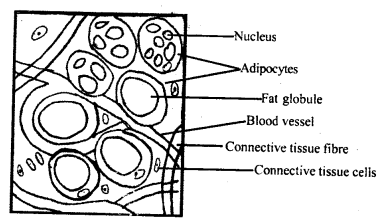
Adipose tissue
Functions: It synthesises, stores and metabolises the fat and forms the insulating layer beneath the skin. It collects around the viscera especially kidneys and prevents them from shock and injury.
Question 5.
Plasma contains three classes of proteins. What are these? Give their functions.
Answer:
The major classes of plasma proteins are
- Albumin,
- Globulins and
- Fibrinogen
Functions of Plasma Proteins:
- The immune bodies are mainly an important constituent of the globulin fraction which provide defence against infection.,
- Fibrinogen and prothrombin are necessary for the coagulation of blood.
- The plasma proteins normally have an osmotic effect of 25 mm Hg and thus influence the exchange of fluid between blood and tissue spaces.
- Plasma proteins mainly globulins are responsible for the viscosity of blood and this help in maintaining peripheral resistance and arterial blood pressure for efficient heart functioning.
- Plasma, proteins act as buffers in maintaining acid-base balance.
- Albumin and globulin proteins retain water in the blood plasma by their osmotic effects and their deficiency lead to oedema.
- Plasma proteins especially the fibrinogen are concerned with erythrocyte sedimentation rate.
- Plasma proteins help in the transport of certain substances like hormones, enzymes, iron and copper etc. in the blood.
- Plasma proteins distribute heat uniformly all over the body.
Question 6.
Describe briefly the external features of cockroach.
Answer:
The cockroach is a nocturnal cursorial and omnivorous insect. It is generally reddish-brown in colour and its entire body is covered by tough chitin. Its body is divided into head, thorax and abdomen.
Head: It is somewhat pear-shaped and is six segmented. It lies at a right angle to the body with the broad side upwards. It articulates with the thorax by the flexible neck. On each side of the head is a large compound eye. A pair of antennae articulate Inspite close to the notches of the compound eyes.
The top of the head is termed a vertex. Mouthparts are chewing and surrounded by five kinds of appendages. These include, the labrum, mandibles, first maxillae, second maxillae and hypopharynx. The neck is slender, flexible and supported by chitinous cervical plates.
Thorax: The thorax consists of three segments – Prothorax, mesothorax and metathorax. Each segment of the thorax is covered by four sclerites. There is a tergum on the dorsal side, a sternum on the ventral side and a pleuron on either lateral side.
The thorax bears three pairs of jointed walking legs, a pair per segment and two pairs of wings in meso and metathorax. Each leg is made of a number of parts-coxa; the trochanter, femur, tibia and tarsus. Their leg is made of a number of parts coxa, trochanter, femur, tibia and tarsus: They are formed as lateral expansions of the
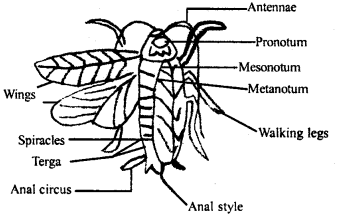
(a) External features of cockroach
integument between the tergum and the pleuron. Each wing is supported by a network of hollow veins. The mesothorax wings are narrow, thick, opaque and leathery and not used in flight.
Head
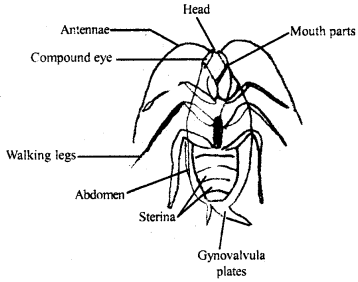
(b) External features of cockroach
Abdomen: The abdomen is ten segmented and covered by four sclerites. There are is all ten-terga, but 9th terga of the male and 8th and 9th terga of the female are covered by 7th tergum. In the female-only the first seven sterna are visible, the seventh, eighth and ninth sterna together form a brood pouch.
The 10th tergum bears a pair of a long tapering structure called anal cerci. In male 9th sternum bears a pair of short unjointed anal styles. They are absent in females. The gonapophyses are very small, irregular arising from the 9th sternum in the male and from the eighth and ninth sterna in the female.
At the posterior end of the abdomen, below the tenth terga, is situated the anus. There, are ten pairs of spiracles on the lateral sides of the body, two on the thorax, eight on the abdomen.
Question 7.
Describe briefly the alimentary canal and digestive glands of the frog.
Answer:
The alimentary canal of the frog is short. It starts with a mouth that is terminal in position. It opens into the buccopharyngeal cavity which contains the maxillary and vomerine teeth and carries the openings of the eustachian tube, vocal sac, gullet and glottis. The gullet opens in a narrow and short tubed Oesophagus which continues In the large stomach. Stomach walls arc highly muscular that help In converting the food into chyme.
The stomach is followed by a coiled small intestine. The small intestine bears a number of finger-like folds called villi and microvilli which increase the surface area for absorption of digested food. Intestine continues into a wider section, opening into the cloaca. The urinary bladder opens into the cloaca. The urinary opens into the cloacal chamber through the ureter.
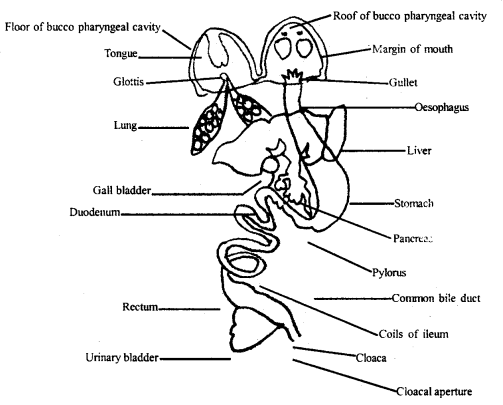
Alimentary canal and digestive glands of the frog
The gastric glands of the stomach bring about the digestion of protein. The liver secretes bile that is temporarily stored in the gall bladder. Bile helps in the digestion of food by changing its pH from acidic to alkaline and by emulsifying the fat. The liver does not secrete any enzyme. The pancreas is situated in a thin mesentery and lies parallel to the stomach.
It secretes pancreatic juice that causes the digestion of protein starch and fats with the help of trypsin, amylase and lipase. Similarly, intestinal juices with their peptidases, lipase and sugar enzymes bring about the digestion of peptides, fats and sugars.
Question 8.
Describe briefly the blood vascular system of the cockroach.
Answer:
The cockroach has an open circulatory system. Blood is colourless and contains plasma with colourless cells, the leucocytes. It does not contain haemoglobin and thus, plays no role in respiration.
The heart is thirteen chambered which is long, narrow, muscular and tube-like structure. The three chambers of the heart lie in the thorax and ten in the abdomen. The posterior end is closed and the anterior end is continued forwards as the anterior aorta. It opens into a haemocoel in the head.
There is a small hole, the Ostia at the posterior side of each chamber. Ostia is guided by valves to allow blood flow only in one direction i.e., from the haemocoel to the inner chamber of the heart.
All the visceral organs are bathed in blood. It consists of a colourless liquid part, plasma containing many corpuscles called haemocytes.
Question 9.
Describe the male reproductive organs in the frog.
Answer:
It consists of a pair of the yellowish testis that is attached to the upper part of the kidneys by a double fold of peritoneum called mesorchium.
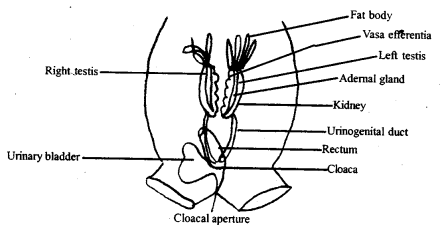
Reproductive organs of the male frog
Each testis contains about 10 to 12 vasa efferentia that run through the mesorchium and enter the kidneys of their side. In kidneys, these open into the bidder’s canal that finally joins with the urinogenital ducts. This cones of the kidneys and finally opens into the cloaca. The cloaca is a small, medium chamber that is used to pass faecal matter, urine and sperms to the exterior.
Question 10.
Draw a labelled diagram of the reproductive organs of an earthworm.
Answer:
Reproduction in Earthworm: The earthworm is hermaphrodite (bisexual). The testes and ovaries are present in the same individual. There are two testes present in the 10th and 11th segments. Ducts that arise from them are called vasa deferentia. The run-up to the 18th segment where they join the ventral side of the 17th and 19th segments.
The prostate and spermatic duct open to the exterior by a pair of male genital pores on the ventrolateral side of the 18th segment. The spermathecae are found one in each of the 6th to 9th segments. They are 4 pairs, they receive and store spermatozoa during copulation.
Two ovaries are attached at the intersegmental septum of the 12th and 13th segments. Ovarian funnels are found beneath the ovaries. They continue into oviducts, join together and open on the ventral side as a single female genital pore on the 14th segment. The development is direct. There are no larval forms in earthworm.
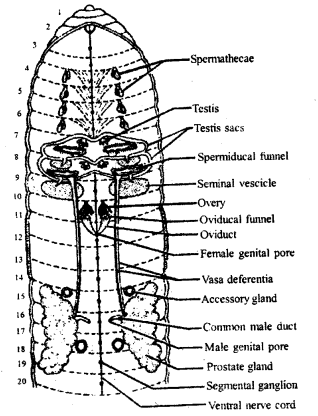
The reproductive system of earthworm
Question 11.
Describe the alimentary canal of an earthworm and interactions with mankind.
Answer:
Alimentary canal of earthworm: Alimentary canal is a straight tube starting from 1st segment to the last segment of the body. It consists of the mouth, buccal cavity, pharynx, oesophagus, gizzard, stomach, intestine and anus. The mouth lies in the first segment.
The mouth opens into the buccal cavity (1 – 3 segment). The buccal cavity leads into the pharynx. The pharynx leads into the oesophagus which is continued into the gizzard. The stomach extends from the 9th 14th segment. The intestine starts from the 15th segment and continues up to the last segment. The alimentary canal opens to the outside by an aperture called the anus.
Interaction of earthworm with mankind:
- Earthworms are the friends of farmers. They make burrows in the soil and make it porous to facilitate respiration and penetration of plant root. Earthworm increases the fertility of the soil by vermicomposting.
- In China, Japan, Burma, Australia, earthworms are used for food.
- Earthworms are used as bait for game fishing.
- In India, earthworms are used for the treatment of stones, jaundice, piles, diarrhoea.
- Earthworms also cause harm by making burrows in the land (damage tender plant).
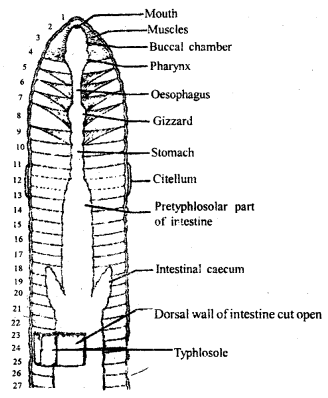
Alimentary canal of the earthworm